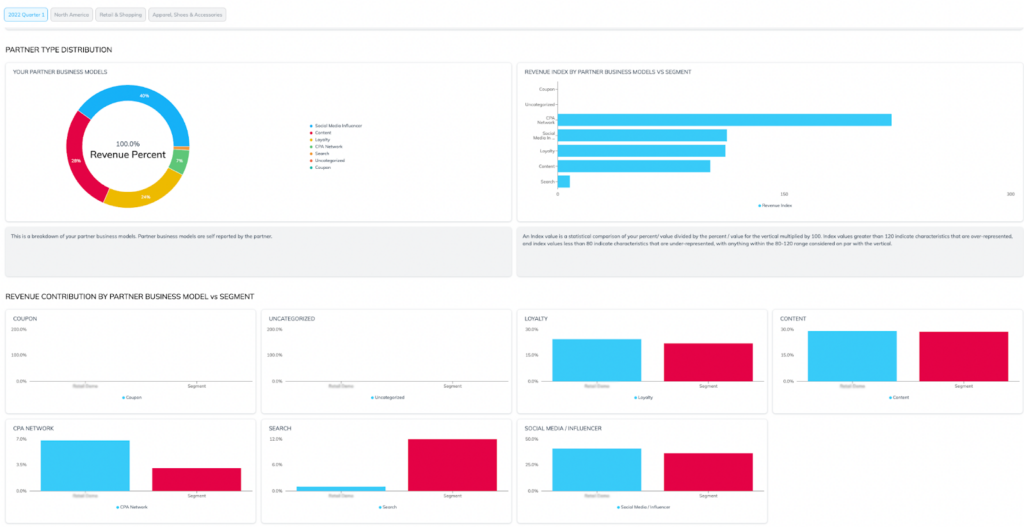Your work isn’t over after you find that ideal affiliate partner. You need a way to determine your partner program’s success and track how it measures up to other brands in your industry.
At impact.com, our clients often describe their struggles with evaluating things like:
- Whether their program size matches up to others in the industry
- The typical commission rates businesses pay partners
- If certain partner relationships are working
- How to find the right way to diversify their partner mix
- How to grow the partnership program
Benchmarking measures your success and helps you create goals for your brand based on your industry peers’ performance. It can help you keep your feet firmly planted while gathering enough contextual insights to move forward with purpose.
What is benchmarking?
Brands often struggle to assess their partner program’s performance due to a lack of applicable data. Your brand and partnership program is unique, but that doesn’t mean you can’t compare yourself to other brands to evaluate your success.
“Benchmarking” measures and compares a brand’s performance and the performance of industry competitors. Brands can then identify how they stack up to the competition and find areas for future improvement.
What does benchmarking solve?
Today, partner management relies heavily on data. Brands want to ensure the effectiveness of their partnerships based on competitors or industry standards.
Solution #1: Know what success looks like
When starting affiliate marketing, many brands struggle to create goals or evaluate their program’s performance because they simply don’t know what success looks like.
That’s why measuring your performance up to the average for the industry can be so helpful.
Comparing your affiliate partners’ statistical success with your industry can help determine whether your partnerships need changing or optimizing.
Here is a view of an affiliate’s performance inside impact.com. Brands can measure these stats against industry benchmarks to see how well an affiliate program performs.

Solution #2: Have an optimized program for growth
Without a systemized process for scaling and improving your partnership program, it’s too easy for it to stagnate.
Benchmarking helps solve this problem by giving you valuable insights into which new partners to recruit and which dormant partners to activate.
Solution #3: Understand partners’ value
Your partnership programs success relies on insights in partner performance. Benchmarking data gives you insights like:
- Whether your partners are doing equally well for your program as they are for your peers
- The top revenue-generating partners your peers are working with (that you are not)
How can advertisers build programs with affiliate marketing benchmarks?
Building an effective affiliate program takes access to expert insights and relevant market data. Benchmarking provides these essential tools by comparing your performance with industry competitors, evaluating and finding gaps in partner performance, and identifying new potential partnerships.
- Comparing partnership program performance (key metrics) with your industry segment
- Comparing partner performance with the segment average and identifying gaps and opportunities for improvement
- Recruiting new partners and activating dormant partners
1. Comparing partnership program performance (key metrics) with your industry segment
Benchmarking provides performance data about marketing costs, profitability, and sales revenue from similar companies in your industry. You can compare variables and identify both the best performers and targets for growth. These insights let you evaluate how to meet your financial, performance, and marketing targets.
For instance, benchmarking can tell whether, compared to your peers, your program has:
- A smaller program size—indicates a recruitment problem
- A lower active rate—indicates an activation problem
- A lower productivity rate—indicates a productivity problem
Affiliate marketing benchmarks also helps you find ways to increase the efficiency of your partner program. This happens by tracking metrics like average order value (AOV), cost per acquisition (CPA), conversion rate, and return on ad spend (ROAS) across the course of your campaign and comparing these metrics to the segment performance.
You can also identify the types of customers your partners are driving to your website. For instance, if you have a high percentage of coupon partners generating revenue for your program, you’ll likely see more bottom-of-funnel consumers already familiar with your brand. You can then identify popular promotional methods among your segment that could be lucrative for you.
With the comparisons available through benchmarking, you can make informed changes to how you run your partner program. Whether you wish to stay aligned with competitor performance or do much better than the typical partner program in your segment, affiliate marketing benchmarks can give you the context you need.
The benchmarking report through impact.com provides a birds-eye view of your competitive segment, which means you’ll receive tangible insights for companies to focus improvement efforts and implement smart goals.

2. Comparing partner performance with the segment average and identifying gaps and opportunities for improvement
Benchmarking helps uncover weak points in your program so you can provide your partners with the support they need.
An affiliate marketing benchmarks report ranks your partners based on revenue, clicks, and recommended actions. It also includes cases with significant differences between ranks for the program and the segment. Using this data, you can compare your top contributing partners to the segment to find significantly under-index partners or potential recruiting and growth opportunities.
You can then use this information to:
- Recognize your top-performing partners to reward them accordingly and keep them motivated
- Recruit partners that are not a part of your program yet but are top revenue-generating partners of the segment
- Identity partners with potential that may need a little extra motivation or training to reach peak performance for your brand
The benchmarking insights found in impact.com assists with identifying gaps and opportunities in your partners’ performance so you can provide the right tools for success.
3. Recruiting new partners and activating dormant partners
The data gathered in the benchmarking process helps advertisers evaluate current partnerships and base outcomes on performance. Brands can use what they learn from successful partnerships to inform their evaluation criteria for present and future partners.
For instance, affiliate marketing benchmarks data can show you:
- Partners that perform well for your segment but may not (yet) be a part of your program
- Dormant partners with the potential to be powerful allies if given the right nudge
- Underutilized business models that you can put to your advantage to increase revenue opportunities
This data gives you the insights needed to grow and maximize partner relationships by providing partner recommendations — which provide additional revenue streams.
How can Benchmarking for Brands help you reach your potential?
In response to this need for scaling partnership programs (and avoiding stagnation) within brand membership programs, impact.com developed a tool called Benchmarking for Brands. This tool facilitates a comparative analysis of key metrics between your partner program and your competitive segment.
The Benchmarking for Brands feature is part of our Optimize offering and is available for retail campaigns in North America (for now). This data allows brands in the retail space to:
- Recruit partners with high revenue potential based on partner recommendations
- See a birds-eye view of the vertical competitive segment and how your program compares to others in the industry
- Eliminate performance gaps by identifying areas of improvement
Ready to try Benchmarking for Brands yourself? Try our demo today!




